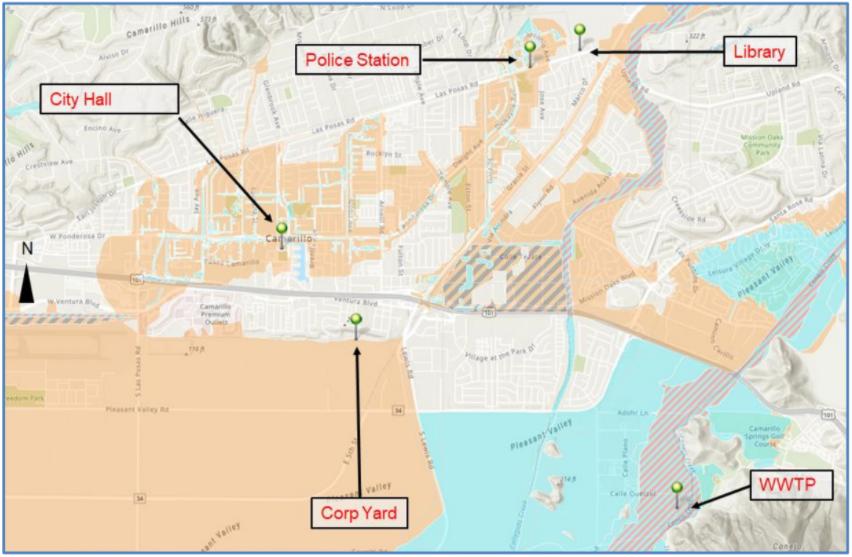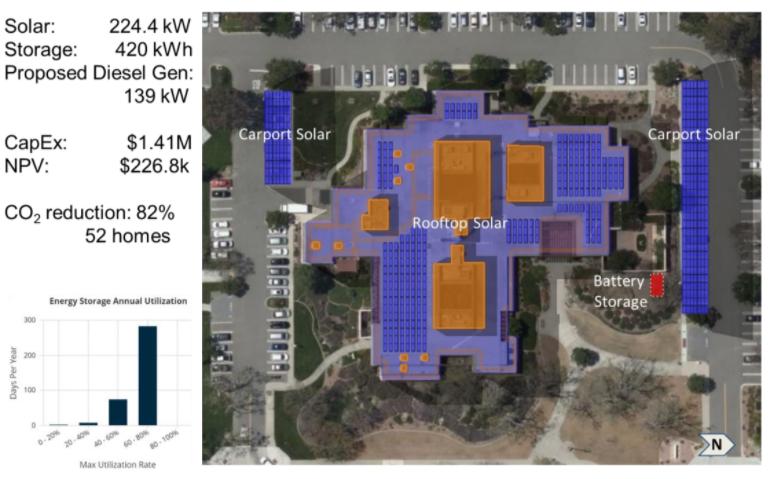The value of viability: When asked to help the City of Camarillo find a solution to frequent natural disaster-related power outages, the Clean Coalition began its work by conducting feasibility studies on possible solutions. Using several modeling tools – including HOMER Grid – the team assessed the economic and technical viability of a prospective microgrid.
Feasibility studies are a powerful tool. The findings can mean the difference between a project’s advancement toward deployment or a return to the design process.
The value of proving viability was demonstrated by the City of Camarillo recently, when, based on a positive feasibility study, council members voted unanimously to move forward with the design of hybrid solar microgrids at five of its facilities. This resounding approval paves the way for successful project development and positive long-term results.
Camarillo, a city of 65,000 just north of Los Angeles, began considering the addition of diesel generators at three of its facilities in early 2018 in an effort to boost reliability and resilience. In an area afflicted by wildfires and natural disasters, the city has experienced numerous power shutoffs to protect public safety and a total of 53 outages in the past five years.
To overcome these challenges, the City engaged the Clean Coalition in 2020 to assess a variety of power provision options.

In order to identify the fundamental needs of the systems, team leads began by prioritizing the project goals with consideration of the economic objectives, environmental goals, and resiliency requirements. The team then acquired data for each site, such as load information, weather and geographic conditions, existing power generation assets, and siting opportunities for new DERs. With this information, they performed technical analyses and modeling to determine the optimal size and configuration, and they conducted an economic assessment to identify the best financing options.
The Clean Coalition uses a variety of modeling tools including HOMER Grid to determine project feasibility. In addition, the organization has developed its own evaluative tool, called the State-of-Charge for Resilience Calculator, for performing Value Of Resilience and Total Critical Load Resilience analyses.
“Project financiers will perform their own due diligence. Therefore, it is helpful to perform feasibility studies using modeling tools and analytical methods that are also used by potential funders, so they can reproduce analyses and confirm the results relatively easily,” explains Clean Coalition Managing Director, Dr. Frank Wasko.

Of the many possible configurations that it evaluated, the study determined that using solar plus storage alone required too much space for solar siting. Due to current policies and market mechanisms, the excess solar generation produced onsite was not monetizable. The analysis also revealed that a storage-only model was too expensive for the required backup of 150% of the normal load for 5 days and that, without the solar, the storage would not provide the economic benefits achieved by time-shifting. Since it operated only during grid outages, the diesel-only model did not provide any utility bill savings whatsoever, while the environmental drawbacks of diesel generators were contrary to the city’s sustainability objectives.
Ultimately, the study found the most viable and economic solution was a hybrid system that incorporated solar, storage, and diesel generation at four of the five sites. It indicated that solar plus storage systems would keep the sites online during short-duration outages, with diesel generators reserved for use as backup only when needed during extended outages. The analysis showed that hybrid solar microgrids would provide tremendous economic benefit through bill savings, as well as cost-effectively exceeding the resilience requirements. Additionally, it revealed that the microgrids would reduce the cumulative carbon footprint of the five sites by approximately 88 percent, supporting the City’s sustainability goals.

“Our feasibility study for the City of Camarillo determined that hybrid solar microgrids will result in significant savings for the City,” Dr. Frank Wasko explained. “The study also showed that the most economically feasible solution that would meet the City’s goals was hybrid solar microgrids that incorporate solar, storage, and secondary backup diesel generation,” he said, explaining that the solar plus storage will provide the City with utility bill savings and resilience over the life of the project, while the diesel provides an extra layer of resilience that allows all loads to be maintained for at least 5 consecutive days.
Over the estimated 30-year life of the projects, the City of Camarillo’s microgrids are projected to achieve zero net energy and provide utility bill savings through reduced demand and energy charges at all five facilities.
This exciting project advancement represents a community’s investment in resilient, cost-effective, and environmentally friendly public infrastructure, as well as an encouraging step forward, made possible by the trustworthy results of comprehensive modeling and feasibility analysis.

UL Solutions HOMER Grid is a market-leading solar-plus-storage software tool for designing grid-tied distributed energy systems. With an integrated utility tariff database and a new module for electric vehicle charging stations, it optimizes peak shaving to help commercial and industrial utility customers lower their demand charges. HOMER Grid can model projects with wind and combined heat and power as well as islanded systems, helping users improve their resiliency. Explore your opportunities with HOMER Grid during a complimentary trial. Learn more and download your complimentary trial.

Great article on City of Camarillo, Homer Team.
Thank you so much for the feedback! We’re pleased that you enjoyed it.